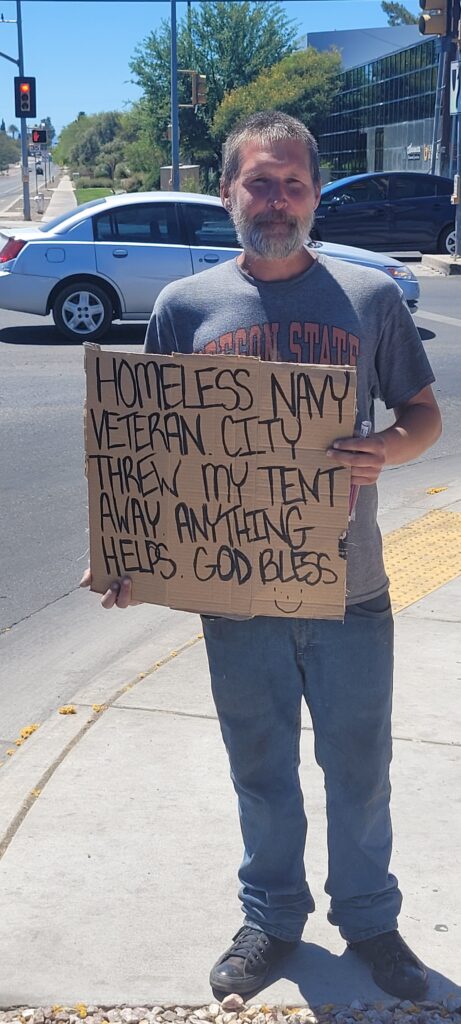How It All Began
I’m a blue collar guy–a handyman. I fix things, make things better–I’m a problem solver. For years, though, as the number of homeless people along my city streets kept increasing, I couldn’t think of a solution. I thought of a lot of ways to help, but nothing provided a solution.
In early 2024, things changed. Circumstances in my world went south, and I ended up starting over again. Sure, I could stay with family or get an apartment, but instead, I did a deep dive into the nearest homeless hangout and started talking to people. More importantly, I listened. I talked to dozens of people in the first few days, and honestly, it took about a week before I met someone who I didn’t find at least somewhat interesting. Drug use was rampant, and we’re talking about nasty drugs like fentanyl and meth. In a lot of ways, it was like the Walking Dead down in the culverts, under the bridges, at the bus stops, in the parks–living on the street–they call it living “in the tunnel.”
It was another two weeks before I ran into someone who wasn’t a regular consumer of recreational drugs. This isn’t to say that everyone was constantly high. In fact, lucidity is much more prevalent than intoxication, but that doesn’t deny the fact that they’re regular users, and substance abuse is not conducive to socioeconomic recovery.
Happily, over weeks and in different settings, I discovered a number of non-addicts who’d simply fallen on hard times and hadn’t played their cards right to work their way out again–a lady and two kids afraid to go home, a couple with medical issues, a veteran who’d been in the tunnel since 2011, people who just couldn’t find a job, a kid with anger problems, a mother of an addict who gave up everything. There were immigrants who couldn’t find housing, an ex-con with nowhere to go, and among others, a disabled man who had been homeless so long that he didn’t really care to try anything else.

I realized I’d misjudged the entire homeless phenomenon. All those years, I’d been looking for a solution to homelessness, but I’d been looking at the problem from my own perspective, not theirs. Suddenly, I realized that the first step to solving homelessness is understanding that homelessness isn’t the problem–it’s a common result of a host of different problems, often piled atop one another to compound the difficulty involved with getting out. “Homeless” is just a convenient, and unfortunately misleading, terminology that lumps a diverse group of complex individuals into a single adjective. Short of Chairman Mao’s thinking, there is not going to be a one-size-fits all solution.
So, I stood there on the outskirts of a group of people in a park and I said to myself, “I can’t help these people.” I’ve had a few friends throughout my life who struggled with drug and alcohol addiction. These terrible drugs require weeks of professional treatment to kick the habit, and unless a guy wants to get clean, he isn’t going to put himself through the horrors of detox. What would be the point, anyway? A couple weeks of living hell, a few months of intense rehab, then what? Unless he’s got a place to stay while he puts his life back together, he’ll be right back on the street, surrounded by the temptation to slip away from the reality of living a pointless life through endless days in the same pair of underwear. “I can’t help these people.”
Then it hit me...
It’s not only impossible to solve this problem all at once, it’s downright dumb to even try. I know that addicts are impossible to help until they’re clean–that’s just the way it is, so there’s no point in providing them with anything other than detox and rehab, neither of which are within my scope. I’ve seen families dump six figures into a single addict with no results–house, vehicles, clothes–gone. So, very simply, unless the person is ready and willing to receive aid, there is no point in investing in them. We have to focus on the people who are capable of succeeding.
I broke it all down into categories of causes that lead to homelessness. Then I eliminated the categories that I felt were beyond my ability to help, like felons released from prison and people with severe mental health issues. This isn’t to say they don’t need or deserve assistance, I just didn’t think I would be able to provide it based on my lack of knowledge about those issues. (I’m happy to report, however, that I’ve been able to help a few felons navigate toward the aid they need.)

Simply, I needed a way for people to help others who need it, deserve it, and most importantly, possess the faculties to succeed after receiving it. In the Venn diagram, there are many homeless people who fall into the Need, Deserve, and Can Succeed categories, but without all three, it’s likely a bad investment. Nobody wants to see their hard-earned wages thrown away without making a dent in the causes we support, but let’s face it, we do it all the time. Don’t get me wrong, the world needs charities to address the causes which plague the world, but we’re not going to “end hunger” by just feeding people on Thanksgiving. Despite our grandest efforts, world hunger still exists. I needed simpler, more focused, deliberate, and realistic goals. The efforts this organization makes to aid our fellow humans are different in one crucial way: they succeed.
How much are we already spending?
This astounded me: I was thinking about all the money our citizens give, whether directly to someone on the street or to an organization which provides services to homeless people, and I came across USICH, which is the federal government’s interagency counsel on homelessness. The Biden Administration had suggested federal spending on homelessness be increased 11% from the 2023 budget to a $10 billion budget in 2025. That means the 2023 budget was around $9 billion. The new suggested budget came at the end of USICH’s Plan to reduce homelessness by 25 percent by January 2025. But, we didn’t get a 25 decrease in homelessness. Instead, nationwide, homelessness was estimated to have increased by 18% since 2023. Adding the $9 billion in federal spending to all the charitable contributions made to homeless-focused organizations, along with all of the dollar bills handed out on street corners across the entire country, and we ended up with an 18 percent increase?! It became quite clear that, as a nation, we’re doing something wrong.
The plan is simple
Some simple math tells us that if 1200 people contributed $1 per week, we could give 300 people a whopping $4. That’s per week. But, if we could gather that $1200 per week and use it to help four people, that’s enough to change their lives.
From my experience, I’ve found that about 97% of homeless people are addicts, and not ready to accept the help needed to escape the tunnel, so out of that $1200, if it were distributed to 300 people at random, about $36 would have even a fair chance of being spent on efforts to get out. $1164 would go to people who aren’t likely trying to get out or aren’t making great decisions when spending their money.
Now think, you know the homeless are receiving far more than $4 per week from street corner donors, but the percentages are still the same. How much money is being wasted on getting people wasted? Yes, a lot of it goes to buying food and other necessities, but how much is being spent on navigating the way back into a home so that the people aren’t back on the street corner with their hand out next week?
The plan is to collect $1/week from 1200 people, and use that money to help people get back on their feet and out of the tunnel for good.
So I created a newsletter, The Tunnel, and sell a subscription to it for $1.11/week. The company that processes the payments, Stripe–the same company that processes payments for Amazon, Apple, Target, Google, Walmart, Etsy, Wayfair, etc–takes a cut. By processing $4.44 every four weeks, they take 44 cents and we end up with the $1 per week.
How hard can it be to get a bunch of people to give $1.11 to help good people escape homelessness? Really, really, really, really, really hard. Very hard. We like entertainment! Americans spend about $263 per month on digital entertainment, including TV and movie streaming. On average, Americans spend $400 a month on their pets. The upcoming Superbowl will fill 62,000 seats at an average cost of nearly $8,000 per ticket. In 2023, Americans spent about $150/month on cell phone service, roughly $100/month on swimming pool maintenance, and $113 billion on lottery tickets. Still, I think it’s fair to say that people who are aware of the homeless problem in America outnumber the people who play the lottery. The amount of money I’m asking for probably isn’t going to put you in a lower tax bracket. $4.44 every 4 weeks. It’s like seventeen cents a day. Look around right now and tell me you can’t afford seventeen cents a day. But, this is what we’re up against. Let’s face it, homeless people just aren’t very entertaining.